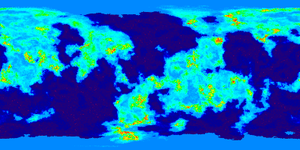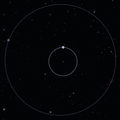Difference between revisions of "Kerbin"
(→Atmosphere: Remove mention of atmospheric density -- this is a constant multiple of atmospheric pressure, so it's not planet-specific and should be on the Atmosphere page.) |
m (Changed smaxis, apoap and periap to match values observed in game (v0.17.1)) |
||
| Line 3: | Line 3: | ||
|File=Kerbin.jpg | |File=Kerbin.jpg | ||
|Parent=Kerbol | |Parent=Kerbol | ||
| − | |smaxis=13, | + | |smaxis=13,338,840,256 |
| − | |apoap=13, | + | |apoap=13,338,840,256 |
| − | |periap=13, | + | |periap=13,338,840,256 |
|orbecc=0 | |orbecc=0 | ||
|orbinc=0 | |orbinc=0 | ||
Revision as of 15:38, 20 November 2012
Kerbin is the home planet of the Kerbals, the location of the Space Center, and the main focus of Kerbal Space Program. It is the Earth analog for the game. It has two moons, named Mun and Minmus.
Kerbin is the third planet in orbit around the star Kerbol. It is the third largest planet (after Jool and Eve) and the fourth largest celestial object around Kerbol (with Tylo, a moon of Jool, being slightly larger).
Reaching a stable orbit around Kerbin is one of the first milestones a player might achieve in the game. Achieving such an orbit with a fuel-optimal ascent[1] requires a delta-V of approximately 4.45 to 4.7 km/s.[2] For many interplanetary missions, this represents over half of the flight's total delta-V requirement. (This is also true of Earth-based interplanetary spaceflights, leading one observer to remark that "If you can get your ship into orbit, you're halfway to anywhere."[3])
Contents
[hide]Topography
|
Kerbin has a roughly equal distribution of surface liquid water and solid land, with polar icecaps and scattered deserts. There are mountains exceeding 3 km in height, with the tallest peak being at least 3750 m in altitude.[4] Note: There will be a change in the appearance of Kerbin coming in version 0.18[5], and that may contribute to geographical change, which obviously affects the topography. All information within this article and note is valid as of version 0.17.1. |
Atmosphere
Kerbin's atmosphere contains oxygen and extends to roughly 69,078 meters. Its atmosphere becomes exponentially less dense as altitude increases (with a scale height of 5 km).[6] In general, the atmospheric pressure on Kerbin, at an altitude expressed in meters, is:
Orbits
Geosynchronous orbit is achieved at an altitude of 0.00 m (1008.9 m/s). A semi-synchronous orbit with an orbital period of 1/2 of Kerbal (3 hours or 10800 seconds) is achieved at an altitude of 0.00 m with an orbital velocity of 0.00 m/s.
Interplanetary Travel
From the lowest stable orbit around Kerbin (70 km), the amount of delta-V needed to reach the orbits of other celestials is as follows:
| Body | Delta-V | |
|---|---|---|
| Mun | ~860 m/s | |
| Minmus | ~930 m/s | |
| Eve | ~1033 m/s | |
| Duna | ~1060 m/s | |
| Moho | ~1676 m/s | |
| Jool | ~1915 m/s | |
Reference Frames
| Paid (0.17) | Demo (0.13.3) | |
|---|---|---|
| Rotational/Inertial transition | 100,000 m | 70,000 m |
| Warp | Minimum Altitude | |
| 1x | Any | |
| 2x | n/a | 0 m |
| 5x | 69,078 m (above the atmosphere) | |
| 10x | 69,078 m (above the atmosphere) | |
| 50x | 69,078 m | 150,000 m |
| 100x | 120,000 m | 300,000 m |
| 1,000x | 240,000 m | 600,000 m |
| 10,000x | 480,000 m | 1,200,000 m |
| 100,000x | 600,000 m | n/a |
Gallery
- NJ6qJ.jpg
A projection map of Kerbin, as of 0.14.1 and before (including the demo).
An accurate full-colour projection map of Kerbin as of 0.14.2 and above.
Changes
- Improved atmosphere visuals.
- Minmus added.
- Much more varied and taller terrain added. Prior to this, some mountain ranges exceeded 600 m in height, but the tallest point was at an altitude of approximately 900 m.[7]
- Mun added.
- Terrain overhaul, oceans became wet.
- Atmosphere extended from ~34,500 m to ~69,000 m.
- Initial Release
Notes
- Jump up ↑ A fuel-optimal ascent is one which (a) minimizes velocity losses to gravity and atmospheric drag and (b) launches eastward (toward the 90 degree heading) to gain 174.5 m/s of orbital velocity for free, thanks to Kerbin's rotation.
- Jump up ↑ Kerbin Delta-V Chart
- Jump up ↑ Robert Heinlein, quoted on page 194 of A Step Farther Out by Jerry Pournelle.
- Jump up ↑ http://kerbalspaceprogram.com/forum/index.php?topic=11388.msg176509#msg176509 [Broken Link]
- Jump up ↑ http://forum.kerbalspaceprogram.com/entry.php/247-A-Brave-New-World
- Jump up ↑ Forum thread 16000, "[KGSS] Examining Kerbin's atmosphere"
- Jump up ↑ http://kerbalspaceprogram.com/forum/index.php?topic=6446.0 [Broken Link]
| |||||





